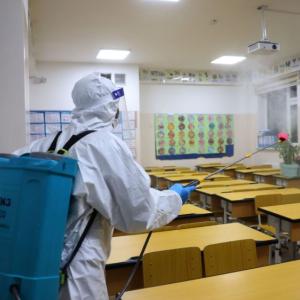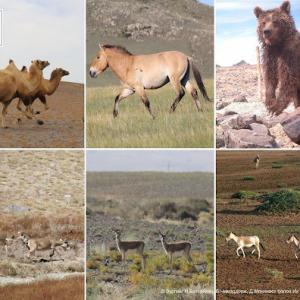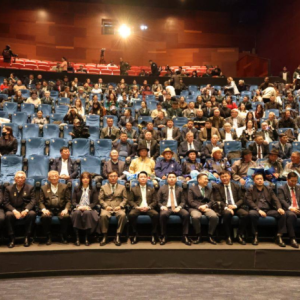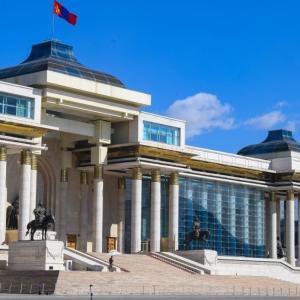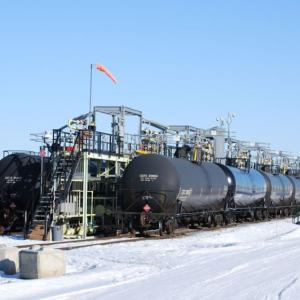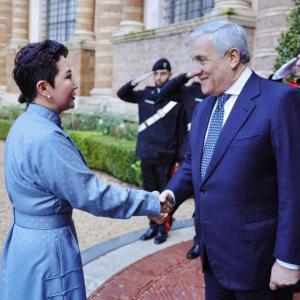Ki-Chul Oh: Nowhere In the World Has the Average Air Temperature Increased by More Than Two Degrees Celsius Except in Mongolia
Society
Ulaanbaatar, November 29, 2024 /MONTSAME/. The “Daily News” newspaper of Mongolia interviewed Ki-Chul Oh, former Chair of the Steering Committee of the Civil Society Network of the United Nations Convention to Combat Desertification and founder of the Green Asia Network international nongovernmental organization.
When did you first arrive in Mongolia? Why did Green Asia Network choose to implement its projects and activities in Mongolia?
The first time I came to Mongolia was with a group of
others in 2000 to research climate change. When I saw the climate change
situation in the countryside, the change was getting very serious. According to
climate research, due to global warming, the average air temperature in other
countries has increased by +0.6 degrees. But in Mongolia, the average air
temperature has risen by two degrees. As our group traveled through the
countryside, most of the land was under desertification. Also, there were many cases
where the rivers and lakes ran out of water and dried up. Since that
experience, I have felt a strong need to be involved and to take action against
desertification in Mongolia. Mongolia's struggles with climate change are not
solely due to its actions. Neighboring developed countries like China, Russia,
South Korea, and Japan engage in significant industrial production and
agriculture, which greatly contributes to global warming. As a result, Mongolia
is one of the countries most adversely affected by these activities. Therefore,
24 years ago, I established the Green Asia Network’s Mongolian branch and
started planting trees and launching initiatives to improve people's
livelihoods.
How many projects is the Green Asia Network implementing in Mongolia? Where are they being implemented and what is the duration of each project?
First, we started with a tree-planting project in Ulaanbaatar City. The reference
model plantation sites for afforestation and combating desertification were
established in 10 soums, such as Baganuur district, Saintsagaan soum in
Dundgobi aimag, Bayannuur and Dashinchilen soums in Bulgan aimag, Ugiinuur soum
in Arkhangai aimag, and Erdene, Argalant, Bayantsogt, and Bayankhangai soums in
Tuv aimag. Our latest project started this year in Gurvanbulag soum, Bulgan
aimag. The first five years of the project are usually dedicated to infrastructure
preparation work. One plantation site should be supported and managed for at
least 10 years. Moreover, empowering and capacity-building among local people
is very important. For example, a model of best practices plantation site and
afforestation area was established in 2007 in Bayannuur soum of Bulgan aimag,
and it has been supporting and empowering local people to this
day. A short-term project lasts for five years, while a long-term project lasts
longer.
“Green
Asia Network” is hiring, training, and providing local jobs for individuals of
all ages and genders. Could you tell us more about this process?
In the beginning, in cooperation with Japan, we planted only trees in Mongolia for three or four years. Unfortunately, all the trees died. The main reason was that herders in the countryside broke the fences, allowing their animals to enter the planting areas and feed on the saplings. I deeply regret the loss of those trees, and I realized that I couldn’t continue with this approach. During the first plantation site establishment in the Baganuur district, we began involving local people in the project and offered them paid work. As a result, 95 percent of the planted trees thrived. Since then, we have decided to engage local communities not only by providing paid employment but also by emphasizing that the plantation site will always be available to them and that collaboration is beneficial for everyone involved. We are an international NGO, and upon completing the project, we will eventually transfer ownership of the plantation sites to the respective local organizations or communities.
Before 2007, one individual now working in the afforestation area of Bayannuur soum in Bulgan aimag was a herder with over 1,300 livestock. Unfortunately, he lost all his livestock during the severe winter "dzud" of 2007. At that time, many young herders left their aimags to find work and earn a living in Ulaanbaatar. However, this man, being older, chose to remain in the countryside instead of relocating to the capital.
That
summer, over 20 people joined us to work because they had also lost their
livestock, and we began our efforts in an empty, barren area. Planting trees,
farming, and cultivating the land proved to be incredibly challenging for the
former herders. Fortunately, Green Asia Network provided them with training,
guidance, and support, helping them transform the area into a beautiful
afforestation site today. These individuals not only planted and nurtured the
trees but also established mutual aid groups and cooperatives.
In Bayannuur soum, Bulgan aimag, we have established four afforestation areas, resulting in the planting of trees across a total of 127,000 hectares. In 2013, more than 40 hectares were handed over to the Ministry of Environment, while the remaining 80 hectares are currently managed by Green Asia Network. Of the 80,000 trees planted, approximately 56,000 have successfully grown and are being cared for and protected. Some of these trees are cultivated as a source of income, and the afforested area includes about 25,000 sea buckthorn trees.
Green
Asia Network is a non-profit organization combating climate change. The
individuals responsible for caring for and protecting the sea buckthorn trees
also process the fruits, turning them into a source of income through sales.
Members of the cooperative in the Bayannuur afforestation area have proposed
that 50 percent of the profits from fruit sales be distributed as dividends.
They suggest that 30 percent should be allocated to a risk fund, and the
remaining 20 percent should cover operating expenses.

What are the main challenges faced when implementing projects locally? How does the Mongolian Government or local government provide support?
Thank you for your important question. The support and cooperation of central and local government organizations are essential for the project’s successful implementation in combating desertification in rural areas. We have established a general Memorandum of Cooperation with the Ministry of Environment and are also signing related cooperation agreements with the local government organizations involved in our projects.
These organizations are responsible for granting land use permits for afforestation activities. For foreign organizations, land permits are typically issued for five years. If the land permit is not renewed upon expiration, we may not be able to continue our operations, posing a significant risk to our project and the trees we planted.
The closure of the project would negatively impact the local environment and community, as over 20 people would lose their jobs and sources of income, affecting their families and children. Fortunately, it has become easier to work with local government agencies lately. In the past, we faced significant challenges, but we often did not address them effectively. However, local people have taken the initiative to solve their problems. A notable example of this is how they identified their issues and presented solutions during meetings with the Citizens' Representatives Khural.
The government has permitted us to plant trees in the afforestation area of Erdene soum, Tuv aimag. However, a mining company suddenly claimed that it had received its permit before us. Their permit was only for mineral exploration. The company informed us that it would conduct exploration activities simultaneously with our tree-planting project. For several years, we have been involved in litigation with this mining company regarding their sand exploration rights in our project area. This ongoing conflict is causing disruptions to our operations, partly due to a lack of coordination among government agencies.
What
is the purpose of your visit to Mongolia this time? What aspects of tree
planting should Mongolia focus more on?
I
came to Mongolia to conduct research. In the past, Mongolia was a
country where very few trees were planted. However, recently, there has been a
significant focus on tree planting due to the "One Billion Trees” national
movement. This initiative is part of the government's efforts to combat global
warming and can be considered one of its effective policies.
As
part of the "Billion Trees" National Movement, Mongolia
should collaborate with various countries, not just the Republic of Korea. Many
developed countries have obligations to the United Nations to support efforts
to reduce greenhouse gas emissions. Potential funding sources for the
"Billion Trees" National Movement could be greatly enhanced by
selling credits based on the amount of greenhouse gas that can be absorbed by
creating green structures per hectare. It would be very effective for
researchers to conduct research in this area and provide validated data on
greenhouse gas absorption.
We have conducted preliminary research in limited afforestation areas. However, these results are not fully confirmed, and ongoing research is necessary. It is estimated that each hectare can absorb approximately six tons of greenhouse gases annually, indicating a significant opportunity to plant over a billion trees. A tree thrives when it is cared for but can die if neglected. Therefore, it is crucial to maintain sustainable practices moving forward.
What
are the benefits of planting trees?
The United Nations evaluates our work from
various perspectives. It recognizes not only the establishment of green
structures but also the importance of additional actions, such
as tree planting and the cultivation of protective windbreaks using sea
buckthorn or fruit trees. From an ecological standpoint, tree planting is
effective in restoring soil health, preventing sand migration, and mitigating
desertification to some extent. Trees absorb water, and areas with tree cover
can reduce dust storms by as much as tenfold. Furthermore, trees protect
against floods, not just dust storms.
 Ulaanbaatar
Ulaanbaatar







